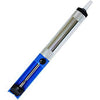TSX Assembly Guide
Damaged or Missing Parts All kits and parts are checked before being shipped to you. If something arrives damaged or if your kit is missing a part, please open a support ticket to inquire about a replacement. Missing parts will be replaced at our expense. Damaged parts should be returned for verification. If the part shows signs of use beyond what was necessary to determine that it was damaged, DIY Recording Equipment, LLC reserves the right not to replace the part.
Thank you for purchasing a TSX Screaming Overdrive Colour!
If this is your first DIY project ever, we recommend reading our Getting Started Guide.
Required Tools
You'll need the tools below to complete this build.

Soldering Iron
We recommend an adjustable-temperature station, such as the $40 Weller WLC100.

Solder
You can use 60/40 "leaded" solder or lead-free. We recommend 60/40 because it flows better and is easier for beginners to use.

Wire Cutters
You'll need a pair of good "snips" for cutting of the excess leads after soldering.
Optional Tools
These tools aren't strictly necessary but can make your build a bit easier.

Multi-Meter
If you find the color bands on resistors a bit hard to read, you can use a meter to sort them with absolute confidence.

Desoldering Pump
If you accidentally solder something in the wrong place, a desoldering pump can save the day.
0. Resistor Calculator
Type in the value of the resistor you need and this tool will show you the corresponding color code.
Bag 1

Place Resistors
Place the resistors in their respective places on the PCB.

Bend Resistors
As you insert each resistor, bend its leads against the bottom of the PCB to keep it in place.

Solder Resistors
Now solder the resistors to the PCB. Observe good soldering technique: heat the pad and lead for 2-3 seconds, apply a small bit of solder, and continue to heat the pad for another 2-3 seconds. Once all of the solder joints have cooled, use your clippers to trim away the excess leads. Your goal should be to clip as close as possible to the joint without clipping the joint itself.
Bag 2

Place 1N914 Diodes
Open bag 2 and locate the diodes—the small, orange parts with a black or yellow stripe. Place these diodes in the D1 and D3 positions on the PCB. Make sure to align the black or yellow stripe on the diode with the white stripe on the PCB. Then solder and trim.

Place Film Capacitors
Solder the larger, red cap in the C1 position and the smaller, yellow caps in the CB1 and CB2 positions. These caps are not polarized, so it doesn't matter which direction you place them in.

Place IC Socket
Place the 8-pin socket in the IC1 position, with the semi-circular notches on the socket and the PCB aligned. Then flip the PCB over and solder the socket in place.
Bag 3

Place 1N34A Diodes and Film Caps
Open bag 3 and remove the two diodes. Although they look very similar to D1 and D3, these diodes are made of a different material. Solder these in the D2 and D4 positions, making sure to align the lines on the diodes and PCB.
Then solder the larger, red cap in the C2 position, and the smaller, yellow cap in C3. These caps are not polarized.

Place Electrolytic Caps
The two remaining caps are polarized, so they must be placed in a particular orientation. The longer lead is positive, while the negative lead is marked by a white stripe on the body. Place the caps in the C4 and C5 positions with the positive (longer) lead in the square pad on the PCB. Then solder and trim.
Bag 4

Place Standoffs and Header
Open bag 4 and pop the standoffs into the four mounting holes from the bottom of the PCB. Insert the locking ends with right-angle tabs into the PCB and leave the removable ends to be inserted into your Palette. Now insert the 8-pin header into the holes marked "CON1." Make sure to place the short, silver pins through the PCB so that the black posts and long, gold pins protrude from the bottom of the PCB. Solder the header to the PCB.

Place IC
Place the 4558D opamp in the socket. Align the dont with the notch in the socket and PCB. You may need to bend the leads of the IC inward a bit to make them fit nicely into the socket.
Final Checks
Before you wrap up, check the following things:
-
Capacitor orientation: Is the stripe on the cap on the opposite side from the "+" marking on the PCB?
-
IC orientation: Does the dot/notch on the IC align with the notches on the socket and PCB?
-
Diode orientation: Do the stripes on the diode match those on the PCB?
-
Resistors: Do all of the resistor positions correspond the chart and/or sorting sheet?
-
Soldering: Is every solder joint shiny and clean? If one is cloudy or misshapen, try reheating it for 8 seconds and adding a tiny bit more solder.
-
Trimming: Are all of the excess leads trimmed down as close to the joint as possible?
All good? Congrats on finishing your build! Have a question or problem? Drop us a line.
Help Us Improve
1
2
3
4
5
6
7
8
9
10



